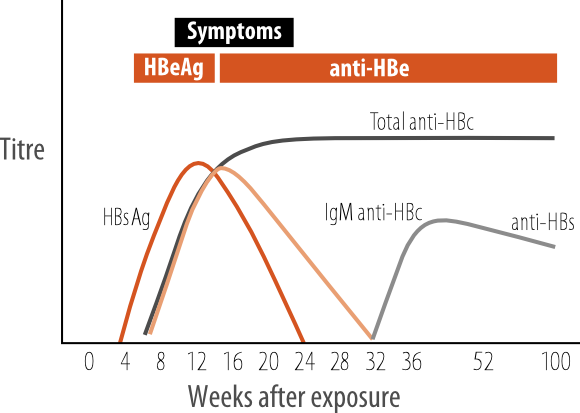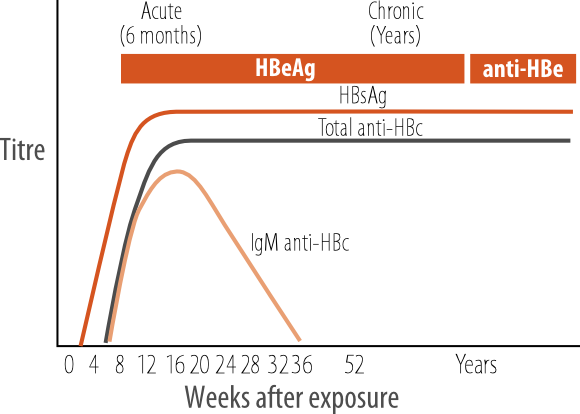Print as PDF
KEY POINTS
- Birth in highly endemic regions such as sub-Saharan Africa and East Asia is a risk factor for developing chronic hepatitis B (CHB) infection (1). The primary mode of transmission in such cases is vertical (i.e., mother to child).
- The risk of developing CHB is highest in those who acquire hepatitis B virus (HBV) infection perinatally and lowest in those who acquire the infection in adulthood.
- The natural history of HBV infection depends on complex interactions between host, virus and environment.
- There are four phases of CHB, and the host immune response in each phase determines the outcome of infection and the severity of liver injury.
- Liver damage is caused by the host immune response rather than the HBV itself.
- Complications of CHB include cirrhosis with hepatocellular failure and hepatocellular carcinoma. All complications can be minimised with effective antiviral therapy.
Click to open GESA recommendation
- World Health Organization (WHO). Global policy report on the prevention and control of viral hepatitis. Geneva: WHO; 2013.
- Australasian Society for HIV Medicine (ASHM). Antenatal testing and blood-borne viruses (BBVs). 2011. Update March 2015.
- Takegoshi K, Zhang W. Hepatitis B virus infections in families in which the mothers are negative but the fathers are positive for HBsAg. Hepatol Res 2006;36:75–7.
- Tajiri H, Tanaka Y, Kagimoto S, Murakami J, Tokuhara D, Mizokami M. Molecular evidence of father-to-child transmission of hepatitis B virus. J Medl Virol 2007;79:922–6.
- Komatsu H, Inui A, Sogo T, Hiejima E, Kudo N, Fujisawa T. Source of transmission in children with chronic hepatitis B infection after the implementation of a strategy for prevention in those at high risk. Hepatol Res 2009;39:569–76.
- Ko YC, Li SC, Yen YY, Yeh SM, Hsieh CC. Horizontal transmission of hepatitis B virus from siblings and intramuscular injection among preschool children in a familial cohort. Am J Epidemiol 1991;133:1015–23.
- Villeneuve JP. The natural history of chronic hepatitis B virus infection. J Clini Virol 2005;34:S139–S42.
- Edmunds WJ, Medley GF, Nokes DJ, Hall AJ, Whittle HC. The influence of age on the development of the hepatitis B carrier state. Proc Biol Sci 1993;253:197–201.
- Lok AS, McMahon BJ. Chronic hepatitis B: update 2009. Hepatology 2009;50:661–2.
- Beasley RP, Hwang LY, Lin CC, Leu ML, Stevens CE, Szmuness W, et al. Incidence of hepatitis B virus infections in preschool children in Taiwan. J Infect Dis 1982;146:198–204.
- Edith Cowan University. Hepatitis Education Project. 2014; Available at: http://hepatitis.ecu.edu.au/(last accessed 21 June 2018).
- Lok AS, McMahon BJ. Chronic hepatitis B. Hepatology 2007;45:507–39.
- European Association for the Study of the Liver. EASL 2017 Clinical Practice Guidelines on the management of hepatitis B virus infection. J Hepatol 2017;67:370-98.
- Livingston SE, Simonetti JP, Bulkow LR, Homan CE, Snowball MM, Cagle HH, et al. Clearance of hepatitis B e antigen in patients with chronic hepatitis B and genotypes A, B, C, D, and F. Gastroenterology 2007;133:1452–7.
- McMahon BJ, Holck P, Bulkow L, Snowball M. Serologic and clinical outcomes of 1536 Alaska Natives chronically infected with hepatitis B virus. Ann Intern Med 2001;135:759–68.
- Hadziyannis SJ, Vassilopoulos D. Hepatitis B e antigen-negative chronic hepatitis B. Hepatology 2001;34(4 Pt 1):617–24.
- Manno M, Camma C, Schepis F, Bassi F, Gelmini R, Giannini F, et al. Natural history of chronic HBV carriers in northern Italy: morbidity and mortality after 30 years. Gastroenterology 2004;127:756–63.
- Chu CM, Chen YC, Tai DI, Liaw YF. Clin Gastroenterol Hepatol 2010;8:535.
- Hsu YS, Chien RN, Yeh CT, Sheen IS, Chiou HY, Chu CM, et al. Long-term outcome after spontaneous HBeAg seroconversion in patients with chronic hepatitis B. Hepatology 2002;35:1522–7.
- Tseng TC, Liu CJ, Yang HC, Su TH, Wang CC, Chen CL, et al. High levels of hepatitis B surface antigen increase risk of hepatocellular carcinoma in patients with low HBV load. Gastroenterology 2012;142:1140–9.
- Chu CJ, Hussain M, Lok AS. Quantitative serum HBV DNA levels during different stages of chronic hepatitis B infection. Hepatology 2002;36:1408–15.
- Yuen MF, Tanaka Y, Ng IO, Mizokami M, Yuen JC, Wong DK, et al. Hepatic necroinflammation and fibrosis in patients with genotypes Ba and C, core-promoter and precore mutations. J Viral Hepat 2005;12:513–8.
- Fattovich G. Natural history of hepatitis B. Journal of Hepatology 2003;39:S50–S58.
- Raimondo G, Caccamo G, Filomia R, Pollicino T. Occult HBV infection. Sem Immunopathol. 2013;35:39–52.
- Yang R, Song G, Guan W, Wang Q, Liu Y, Wei L. The Lumipulse G HBsAg- Quant assay for screening and quantification of the hepatitis B surface J Virol Methods 2016;228:39–47.
- Raimondo G, Pollicino T, Cacciola I, Squadrito G. Occult hepatitis B virus infection. J Hepatol 2007;46:160–70.
- Gupta S, Govindarajan S, Fong TL, Redeker AG. Spontaneous reactivation in chronic hepatitis B: patterns and natural history. J Clin Gastroenterol 1990;12:562–8.
- Terrault NA, Bzowej NH, Chang KM, Hwang JP, Jonas MM, Murad MH, et al. AASLD guidelines for treatment of chronic hepatitis B. Hepatology 2016;63:261-83.
- Yeo W, Johnson PJ. Diagnosis, prevention and management of hepatitis B virus reactivation during anticancer therapy. Hepatology 2006;43:209–20.
- World Health Organization (WHO). Hepatitis B fact sheet. Updated 5 July 2017. Geneva: WHO, 2017.
- Fattovich G, Giustina G, Schalm SW, Hadziyannis S, Sanchez-Tapias J, Almasio P, et al. Occurrence of hepatocellular carcinoma and decompensation in western European patients with cirrhosis type B. Hepatology 1995;21(1):77–82.
- Chen CJ, Yang HI, Su J, Jen CL, You SL, Lu SN, et al. Risk of hepatocellular carcinoma across a biological gradient of serum hepatitis B virus DNA level.JAMA 2006;295(1):65–73.
- Yang HI, Lu SN, Liaw YF, You SL, Sun CA, Wang LY, et al. Hepatitis B e antigen and the risk of hepatocellular carcinoma. N Engl J Med. 2002;347:168–74.
- Schiff ER. Prevention of mortality from hepatitis B and hepatitis C. Lancet 2006;368:896–7.
- Bosch FX, Ribes J, Borras J. Epidemiology of primary liver cancer. Semin Liver Dis 1999;19:271–85.
- Fattovich G. Natural history and prognosis of hepatitis B. Semin Liver Dis 2003;23:47–58.
- Parker C, Tong S, Dempsey K, Condon J, Sharma S, Chen J, et al. Hepatocellular carcinoma in Australia’s Northern Territory – high incidence and poor outcomes. Med J Aust 2014;201:470-4.
- El-Serag HB, Richardson PA, Everhart JE. The role of diabetes in hepatocellular carcinoma: a case-control study among United States Veterans. Am J Gastroenterol. 2001;96(8):2462–7.
- Marrero JA, Fontana RJ, Fu S, Conjeevaram HS, Su GL, Lok AS. Alcohol, tobacco and obesity are synergistic risk factors for hepatocellular carcinoma. J Hepatol 2005;42:218–24.
- Loomba R, Liu J, Yang HI, Lee MH, Lu SN, Wang LY, et al. Synergistic effects of family history of hepatocellular carcinoma and hepatitis B virus infection on risk for incident hepatocellular carcinoma. Clin Gastroenterol Hepatol 2013; 11:1636-45.
- Bosch FX, Ribes J, Cleries R, Diaz M. Epidemiology of hepatocellular carcinoma. Clin Liver Dis 2005;9:191–211, v.
- McMahon BJ. The natural history of chronic hepatitis B virus infection. Hepatology 2009;49:S45–S55.
- Varbobitis I, Papatheodoridis GV. The assessment of hepatocellular carci- noma risk in patients with chronic hepatitis B under antiviral therapy. Clin Mol Hepatol 2016;22:319–26.
- Papatheodoridis G, Dalekos G, Sypsa V, Yurdaydin C, Buti M, Goulis J, et al. PAGE-B predicts the risk of developing hepatocellular carcinoma in Caucasians with chronic hepatitis B on 5-year antiviral therapy. J Hepatol 2016;64:800–6.
- Brouwer W, Hansen B, Raffetti E, Donato F, Fattovich G. The PAGE-B score stratifies chronic hepatitis B patients with compensated cirrhosis at high risk of hepatocellular carcinoma development with good accuracy. Hepatology 2015;62 (Suppl):93A–207A.
- Brouwer W, van der Meer A, Boonstra A, Plompen E, Pas S, de Knegt R, et al. The PAGE-B score accurately predicts clinical outcome and outperforms other biomarkers over 15 years of follow-up in a diverse cohort of chronic hepatitis B patients. Hepatology 2015;62 (Suppl):93A–207A.
- Iloeje UH, Yang HI, Su J, Jen CL, You SL, Chen CJ, et al. Predicting cirrhosis risk based on the level of circulating hepatitis B viral load. Gastroenterology 2006;130:678–86.
- Sung JJ, Tsoi KK, Wong VW, Li KC, Chan HL. Meta-analysis: Treatment of hepatitis B infection reduces risk of hepatocellular carcinoma. Alimentary Pharmacol Ther 2008;28:1067–77.
- Kim CH, Um SH, Seo YS, Jung JY, Kim JD, Yim HJ, et al. Prognosis of hepatitis B-related liver cirrhosis in the era of oral nucleos(t)ide analog antiviral agents. J Gastroenterol Hepatol 2012;27:1589–95.
- European Association for the Study of the Liver. EASL recommendations on treatment of hepatitis C 2016. J Hepatol 2017;66:153–94.
- De Monte A, Courjon J, Anty R, Cua E, Naqvi A, Mondain V, et al. Direct- acting antiviral treatment in adults infected with hepatitis C virus: Reactivation of hepatitis B virus coinfection as a further challenge. J Clin Virol 2016;78:27–30.
- Ende AR, Kim NH, Yeh MM, Harper J, Landis CS. Fulminant hepatitis B reactivation leading to liver transplantation in a patient with chronic hepatitis C treated with simeprevir and sofosbuvir: a case report. J Med Case Rep 2015;9:164.
- Collins JM, Raphael KL, Terry C, Cartwright EJ, Pillai A, Anania FA, et al. Hepatitis B virus reactivation during successful treatment of hepatitis C virus with sofosbuvir and simeprevir. Clin Infect Dis 2015;61:1304–1306.
- Wang C, Ji D, Chen J, Shao Q, Li B, Liu J, et al. Hepatitis due to reactivation of hepatitis B virus in endemic areas among patients with hepatitis C treated with direct-acting antiviral agents. Clin Gastroenterol Hepatol 2017;15:132–136.
- Raimondo G, Pollicino T, Squadrito G. What is the clinical impact of occult hepatitis B virus infection? Lancet 2005;365:638–40.


